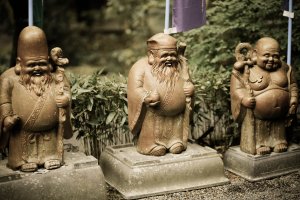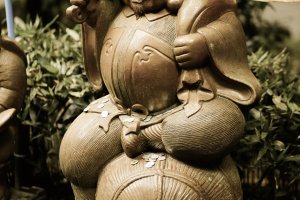The temple grounds of Sekizan Zen-in are famous for the colorful maple trees in autumn, but there is much more than that; the temple is full of interesting history and part of the pilgrimage to the "Seven Lucky Gods".
History
Founded in 888 AD it belongs to the Tendai sect (a Japanese school of Mahayana Buddhism) of Enryakuji Temple on Mt. Hiei. The head master of the Tendai sect, Jikaku-Daishi (Ennin), had gone to Tang China to study Tendai Kyogaku and had stayed there for 10 years mastering it. While sailing back to Japan, due to seasonal winds he was blown back to China, where he visited "Sekizan-Miyojin" in Santosho, China and prayed for his safe return home. At last he returned to Japan in 848 AD and worked hard towards the completion of his master's unfinished works.
When Jikaku-Daishi (Ennin) was dying, he requested his followers to establish a temple in Japan and that should be named "Sekizan" so that the vow he made in China when praying for his safe return home would be kept.
Location & Significance
Sekizan Zen-in is situated in the Northeast of Kyoto, the direction from which the evil influences are likely to come. According to the yin-yan philosophy the temple gate is called "Omote Kimon" (Outer demon gate) which is used as protection from the bad luck coming through the gates.
Fun fact: There are ceramic monkeys (saru) on the roofs of the temple, and there are similar monkey images on the roofs of the Kyoto Imperial Palace facing towards them and theoretically they see and protect the entire area around northeast.
Importance
Pilgrimage of the Miyako Shichifukujin (Seven Gods of Fortune or Seven Lucky Gods): It is said to have been originated here, at the temple of Fukurokuju, the God of Wealth and Longevity.
Mystic Tendai ("asthma sealed-gourd incantation"): The incantation prayer of the asthma sealed gourd Kaji is said to have reduced the diseases like bronchitis and asthma, which is known as "Loofah incantation", a mystic Tendai practiced every year on the full moon of the autumn. Please contact the temple in advance as it happens only once in a year.
Sekizan Kugyo: A training routine of 1,000 day practice of repeat climbing Mt. Hiei up and down, to and fro—the most difficult of Tendai sect practices. A feature of this discipline is to descend from Mt. Hiei and come down to Sekizan Temple for prayers and only then this training is known to be complete.
Why Visit
A temple of Sekizan Myojin, a deity of longevity and wealth, with a history of almost 1100 years, with stories and culture in every corner and stunning autumn leaves. The walking trail in its hill-top garden will definitely leave you mesmerized. Last but not least, the beautiful small shrines amongst the moss covered trees, where the seven lucky gods await you with all their blessings and good wishes.
































-97003.jpg)
-133361.jpg)

